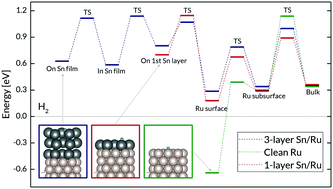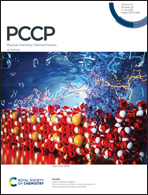Tin deposition on ruthenium and its influence on blistering in multi-layer mirrors†
Abstract
An atomistic description of tin deposition on ruthenium and its effect on blistering damage is of great interest in extreme ultraviolet (EUV) lithography. In EUV machines, tin debris from the EUV-emitting tin plasma may be deposited on the mirrors in the optical path. Tin facilitates the formation of hydrogen-filled blisters under the ruthenium top layer of the multi-layer mirrors. We have used Density Functional Theory (DFT) to show that tin deposition on a clean ruthenium surface exhibits a film-plus-islands (Stranski–Krastanov) growth mode, with the first atomic layer bonding strongly to the substrate. We find that a single tin layer allows hydrogen to reach the ruthenium surface and subsurface more easily than on clean ruthenium, but hydrogen penetration through the tin film becomes progressively more difficult when more layers are added. The results indicate that hydrogen penetration and blistering occur when only a thin layer of tin is present.



 Please wait while we load your content...
Please wait while we load your content...